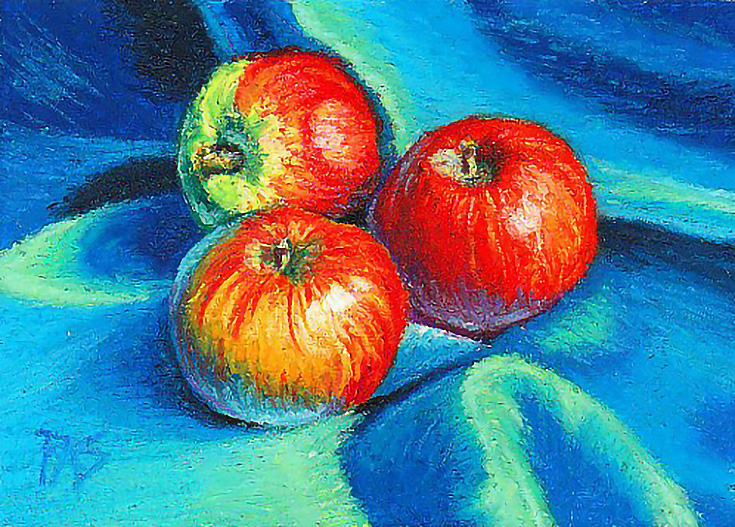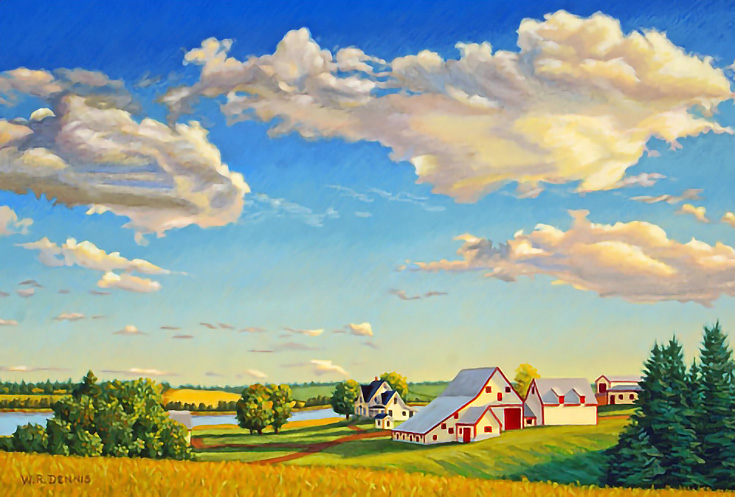How Much Does a Art Ckit 101 Cost the Cheapest
All images in this article have been used with permission and are copyright their corresponding artists. Click the images to visit the artists' websites and learn more.
The first time I saw a set of oil pastels was at a drugstore in a very small display of art supplies. It price a dollar and change for a fix of 24, two dollars and alter for a larger ready of 36. The colors looked bright, the oil sticks were short, round and wrapped, and the box cheerily announced that everything within was not toxic and safe for children.
Quick announcement - EmptyEasel has created a quicker, easier way for artists to have their own art website. Click hither to learn more and become a unproblematic fine art website of your own!
I lumped it in with children'due south watercolor sets and crayons, just from its price and presentation, and passed it by.
Afterward on in New Orleans when I was first starting out as a street artist, I reconsidered the medium. Compared to artist-grade colored pencils, oil pastels were very cheap.
Later on studying a package, I discovered that I could thin them with oil mediums and decided that it would be an inexpensive way to practise some oil paintings, and then I picked up a set of 24, along with a bottle of turpentine and some sheet boards, and got started.
I wasn't a very good painter but the resulting thin-wash paintings were, as promoted, genuine oil paintings. I priced them appropriately between $v and $10 and used the proceeds to buy tube oils and stretched canvases, soon leaving oil pastels behind.

I had no idea that professional-form oil pastels had existed since 1949 when Henri Sennelier created a soft flossy oil pastel stick for Pablo Picasso.
A brusque history of oil pastels
The very outset oil pastels were made in 1925 by Sakura and named Cray-Pas because they were a cross between the make clean dustless ease of crayons and the brilliant saturated colors of traditional soft pastels.
Talens of Holland also created some Panda oil pastels in 1930, but the medium really took off when Picasso and painter Henri Goetz spoke to Henri Sennelier nigh creating something with traditional artist pigments.
Goetz wanted something he could utilise to outset an oil painting: a sketch medium that would blend correct in with painted layers. Picasso on the other hand just wanted to leave his brush behind and depict or paint direct on the sail.
Sennelier ended upwardly making a range of 48 colors that were heavy on the subtle grays and earth tones that Picasso requested. He produced forty sticks of each color, and Picasso bought 3/4ths of those, so Sennelier put the remaining 10 of each in his store where they sold out fast. Naturally, he continued to make them, and Senneliers became the first artist grade oil pastel available.
Oil pastel brands for sale today
Different soft pastels or colored pencils, professional person oil pastels are not available from dozens of manufacturers. There are simply a few expert artist-class brands, each of which has its own proprietary formula.

Sakura withal produces Cray-Pas oil pastels, merely in several grades—children's Cray-Pas Junior Artist; student-class circular wrapped Expressionists, which many artists use for sketching to salvage coin; and the last and all-time are creative person-grade Cray-Pas Specialists, which are square wrapped sticks.
Cray-Pas Specialist pastels are the hardest oil pastel sticks you tin can discover, followed in order of hardness past Cretacolor Aqua Stic, Erengi Art Aspirer, Caran d'Ache Neopastel and Holbein. The softest are Sennelier Oil Pastels which are at present available in 120 colors.
Van Gogh Extra Fine Artist Oil Pastels are usually billed every bit good student-course oil pastels, but share many qualities with these artist-grade brands. Depending on your awarding, they may be adept enough to include in the list above.
Oil pastel prices are comparable to artist-grade colored pencils or soft pastels without quite reaching the price of loftier-finish soft pastels.
In addition, but two brands, Holbein and Sennelier, include toxic mineral pigments such equally Cadmiums and Cobalt. All others use strictly nontoxic hues.
What to buy when starting out
If yous're interested in trying creative person-class oil pastels you should either look for an inexpensive small set up in one of the major creative person-grade brands, or choose your favorite painting colors and put together your own palette from open stock.
Compare open stock prices to the cost of sets—for some brands in that location's no existent bargain to buying large sets other than getting the box or can designed to store them.

Ii good books are available for oil pastels: Oil Pastel for the Serious Beginner and Oil Pastel: Materials and Techniques for Today's Creative person. The first is past John Elliott and the second is by Kenneth Leslie.
Either one is a good beginning volume for artists interested in oil pastels, but Kenneth Leslie's book is much more than exhaustive and varied in its treatment of the medium.
To my pleasant surprise, both of these books demonstrated the gorgeous realism that can be achieved with artist-grade oil pastels. But as with traditional oil paints or colored pencil, you can create potent Impressionist furnishings, layer colors, and re-work areas equally necessary to go the fine detail of realism or hyper-realism.
Tips and techniques for using oil pastels
Like colored pencils, the hardness of each stick contributes to a dissimilar purpose. Many artists combine dissimilar brands of oil pastels to achieve dissimilar furnishings.
Firm brands like Cray-Pas Specialist or Erengi are better for early layers, fine details and control. Softer products like Holbein or Sennelier can exist used when the surface tooth is fully saturated over heavy layers of the house oil pastels.

Oil pastels can be used wet or dry on any back up: paper, board, sail, glass, metallic, wood. . . fifty-fifty stone. Some surfaces work improve with a glaze of gesso, for preservation or more than tooth, merely you can be confident in using an oil pastel over whatever kind of establish objects in a collage or mixed media slice.
Colors may exist blended completely on the surface, scumbled over each other in layers, or blended on the palette then applied with a knife or Color Shaper tool.
Go on in mind that they should not be practical heavily nether a traditional oil painting without a good thinning of turpentine, equally oil pastels have mineral oils in the binder that never completely dry out. Care for them as "actress fat" in relation to oils in mixed media—the oil pastels layers should be the outermost.
As I found out in New Orleans, it's too easy to use a wet brush to mix thin washes and pigment directly from the oil pastel sticks, or just wash medium over areas already drawn for that blended look.
New tools take also made it easier to get fine detail and painterly effects. Rubber-tipped Color Shapers in both the grey business firm texture or the dark gray Clay Shaper actress business firm texture are very good for pushing color around and applying small details. (The soft white-tipped color shapers are better with soft pastels and should be kept split up.)
Sgraffito effects are much easier with oil pastels than with crayon. Laying a strong layer of white or a lighter colour on first and so post-obit information technology with other opaque layers allows you to scrape information technology back to reveal small details or create sharp lines in the work.
This is an old oil painter's fox—oftentimes accomplished with the end of a brush—but it works just equally well in oil pastels and is i of the important keys to realism.
Temperature affects the firmness of all oil pastels, student or creative person-grade. When warm, they'll be softer and flow more easily. When cooled, they become more firm.
This tin assistance in both directions—if your surface is saturated and won't take more color, y'all can warm the pastels in your hand while the painting is in the refrigerator cooling to firmness. If your oil pastels are also soft to control (a common complaint about Senneliers) chilling them for a while should make them easier to handle.

Sparse washes are also possible with any oil painting medium, from linseed oil to odorless turpentine or booze.
One oil pastel brand, Cretacolor Aqua Stic, is watersoluble and has a medium-business firm texture with a range of 80 colors. This allows artists to create fractional-wash furnishings within the aforementioned painting. An area painted with any of the other oil pastel brands won't melt when water is sprayed on to deliquesce the Aqua Stic passages.
Another major reward of Cretacolor'southward Aqua Stic brand is that artists with a strong sensitivity to oil painting mediums can notwithstanding apply them. Aqua Stic oil pastels can as well be combined with whatever other water-based mediums, still are still business firm plenty to sharpen with a crayon sharpener or knife to get fine details.
Supports, glazes, travel considerations, etc.
Oil pastel paintings should ever be glazed when finished, unlike traditional oil paints which cure hard inside a few months afterward finishing a painting. Some brands of oil pastels practice harden somewhat, but non to the level that an oil or acrylic painting will, which means the surface tin't be dusted without smearing the paint.
Two brands of fixative are formulated specifically for oil pastels: Caran d'Ache Protector Fixative is useful for preventing wax bloom, something that Neopastels may endure from just equally nearly colored pencils paintings do.
Sennelier D'Artigny Oil Pastel Fixative forms a hard clear varnish with several sparse applications and some artists will use it to simply varnish heavily rather than glaze their finished paintings.

Traditional pastel papers and supports piece of work just likewise for oil pastels, particularly the sanded pastel supports like Ampersand Pastelbord, Wallis Sanded Pastel Newspaper and Colourfix Sanded Pastel Paper. Whatever actress tooth helps the creative person add more layers and depth to the painting.
My personal favorite is Colourfix. Using clear Colourfix primer as a barrier over my sketches, I tin go along my graphite or charcoal from blending into the lighter oil colors.
Other advantages of oil pastels (as well being dustless) are their size, portability and ease of use—especially for plein air applications. Many artists use oil pastels for field studies because the color ranges are just every bit vibrant as traditional oil paints, but much more handy for carrying effectually.
If you are flying to an exotic location and want to bring some art supplies, oil pastels should always be described as "creative person crayons" to the customs people. (They're nonflammable, non-explosive and completely safe).
Y'all'll want to get out your mineral spirits at home, of form, so pick some up once yous arrive at your destination.
The more that I detect about oil pastels, the more interesting they become—and the more I realize that what you can do with this medium is merely limited by your imagination and skill.

NOTE: You may also be interested in EE's step-by-stride drawing guide for artists. Click below to learn more than!

This mail may contain affiliate links.
Source: https://emptyeasel.com/2009/01/22/oil-pastels-101-a-comprehensive-guide-to-painting-with-oil-pastel/
0 Response to "How Much Does a Art Ckit 101 Cost the Cheapest"
Post a Comment